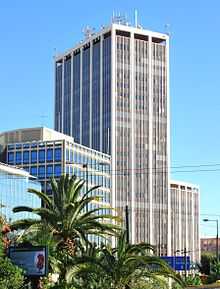Greek economic miracle
The Greek economic miracle is the period of sustained economic growth in Greece from 1950 to 1973. During this period, the Greek economy grew by an average of 7%, second in the world only to Japan.[1]
Economic growth


Greek growth rates were highest during the 1950s, often exceeding 10%, close to those of a modern "tiger economy". Industrial production also grew annually by 10% for several years, mostly in the 1960s. Growth initially widened the economic gap between rich and poor, intensifying political divisions. The term "miracle" is actually little used in Greece.
From 1941 to 1944, Axis occupation of Greece during World War II and the fierce fighting with Greek Resistance groups had unprecedented devastating effects on the infrastructure and economy (notably, forced loans demanded by the Occupying Regime severely devalued the Greek drachma). Furthermore, after the end of the World War, Greece engaged in a bitter Civil War until 1949. By 1950 the relative position of the Greek economy had dramatically deteriorated. The income per capita in purchasing power terms fell from 62% of France's in 1938 to about 40% in 1949, according to economist Angus Maddison.[1]
The rapid recovery of the Greek economy from 1949 was facilitated by a number of measures, including (in addition to the stimulation, as in other European countries, connected with the Marshall Plan) a drastic devaluation of the drachma, attraction of foreign investments, significant development of the chemical industry, development of tourism and the services sector in general and, last but not least, massive construction activity connected with huge infrastructure projects and rebuilding in the Greek cities.
The latter is connected to the dramatic effect this economic growth had on Greek society and the development of its cities. This resulted in an "urban renewal" that replaced the country’s pleasant urban landscape of mostly low-rise buildings and homes with a monotony of characterless concrete blocks in most big towns and cities.
Marginal GDP contractions were also recorded in the 1980s, although these were partly counterbalanced by the evolution of the Greek black economy during that time.
In total, the Greek GDP grew for 54 of the 60 years following WWII and the Greek civil war.[2] From 1950 until the 2008 economic crisis, with the exception of the relative economic stagnation of the 1980s, Greece consistently outperformed most European nations in terms of annual economic growth.[3]
Between the early 1970s and 1990s, double digit inflation, often closer to 20% than 10%, was normal until monetary policies were changed to comply with the criteria for joining the Eurozone. [4]
Gallery
-

Iron ore mine in Thasos (1958)
-

Shiploading in Limenaria, Thasos, during the 50s
-

Xenia hotel in Paliouri, Chalkidiki (1962)
-

Microcar Attica 200 of Attica automobiles (1963)
-

Specifically developed for Africa and the Middle East, the Desert Bus of Biamax (1964)
-

OTE Tower of Thessaloniki opened in 1966
See also
Post-war economic growth:
- Post-World War II economic expansion
General:
Notes
- ↑ 1.0 1.1 Angus Maddison," Monitoring the World Economy 1820-1992", OECD (1995)
- ↑ Paul Bairoch, "Europe's GNP 1800-1975," The Journal of European Economic History, a. 5, no. 2 (1976), pp. 273-340. ISSN: 0391-5115
- ↑ IMF and World Bank April 2008 data
- ↑ http://www.global-rates.com/images/charts/gr-inflatie-chart-14-2043.jpg
Further reading
- Takis Fotopoulos, "Economic restructuring and the debt problem: the Greek case," International Review of Applied Economics, Vol. 6, No. 1 (1992). Retrieved: 5 May 2010.
| |||||||||||||||||||||||||||||||||||||||||||||||
